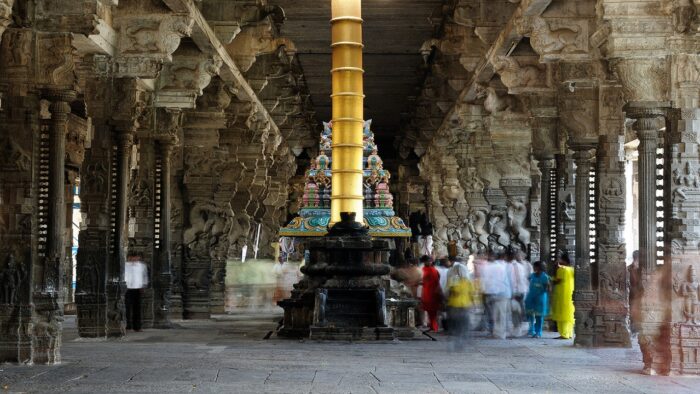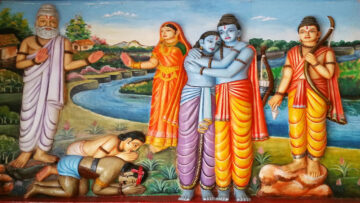Śaivāgama-s are the revealed texts which describes the ālaya-s as sacred spaces where prayers are performed for the benefit of all beings in the Universe. It contains the prescriptions and proscriptions to be followed by the ācārya-s, the rulers, the dharmakartā-s and the bhakta-s at the temple. The tradition believes that the devotee – the individual soul – ‘paśu’ is guided by the ācārya, who is Lord Śiva (pati) himself in the form of a human being[1].
While there is some research on the duties of the ācārya in the temple, there is not much research on the duties of the individual devotees. This paper details the pramāṇa-s from the āgama-s and related texts about the role and the duty of the devotee at the temple which could be practiced today.
The Hindu devotee goes to the temple for darśan or to see and be seen by the Lord. However, the devotee’s role is important in two ways – their presence in the temple should be aligned with the āgama-s so that it helps to maintain the sanctity of the temple and secondly – their devotion in following the sacred texts enables them to experience śivānubhūti, the experience of Śiva, faster and finally be with the Lord after exhausting all the births.
Even for a normal journey from one place to another, we have some system to be followed which guides us to reach the destination without any hurdles. This journey towards Lord Śiva is higher than any travel and for this to be safe and comfortable, our religious texts have detailed many methods.
The Lord is kind to have given many options to the devotees like the parent’s care to their children. The āgama-s guides how a devotee should purify himself before he enters the temple space and the thought process of the devotee is also explained in detail. List of sevas like collecting flowers for the prayers, cleaning the sacred space, preparing the garlands for the prayers, chanting the hymns, serving the devotees, seeing the ācārya as Lord Siva, preserving the nandavanam, conserving the nature and many more.
Sri Sekkiḻār Svāmigal in The Periya Purāṉam, one of the twelve Tirumurai[2], records the historical events of sixty-three nāyanmār-s[3] detailing various seva-s of a devotee who were able to attain the mokṣa by the blessings of Lord Śiva and Goddess Śakti.
This paper also attempts to understand the conditions prevailing today and what are the solutions given in the sacred texts. Since human nature and conditions are diverse, āgama-s guide devotees in many ways. Different types of snāna-s, vrata-s and other practices are designed depending upon the maturity and the situations in which the individual is living.
Just as an object when manufactured is accompanied by a user’s guide, the vedas and āgama-s are revealed by Lord Śiva to guide the paśu-s – the individuals. The temple – the śaiva sacred space serves as the portal in connecting the whole universe and the individual soul through Lord Śiva.
The following are the key guidelines for śaiva devotees.
- Waking up at Brahma Muhūrta – The body that has been given to us is to exhaust the karma-s both the good and the bad to reach Lord Siva. The body is connected with the environment we exist in. The bhakta should wake up at Brahma Muhūrta[4] (between 4:30 am and 6:00 am). He should meditate upon Lord Śiva in his heart in the form of fire and pranavākāra.
- Dantadāvanam (Cleaning the teeth) – Teeth should be cleaned to remove the mala (dirt)[5] using the dantakāṣṭham. Different types of trees are prescribed to be used as effective teeth cleaners.
- Mala Visarjanam (Attending nature’s call) – The impurities in the body have to be cleaned by attending nature’s call. Specific directions and places are mentioned. It also directs how the sacred thread should be worn while excreting[6].
- Snānam (Taking the holy bath): The devotee should take his bath at the sea, river, lake, pond or at his home. The hands are considered to be the Sun and the Moon. He should chant the mantra-s that have been initiated and utter auspicious words. The snāna here denotes the water to be poured from the head to the toe. When taking a bath at sea the whole of the body has to be immersed in the water. At home the bath should be done with pure water. If needed, hot water can be used. After completing the bath, the bhakta should feel his śarira’s cleanliness and his mind is also being purified by undergoing the snāna[7]. People who are unable to have their bath in the prescribed form can proceed with whatever is possible[8].
- Bhasmasnānam (Applying of the holy Vibhūti): Wearing the vibhūti – the holy ash is considered to be as pious as taking a bath in the holy Ganges[9]. The letter “bha” denotes “bhakshanāt” – literally the sins are scoured away by wearing the ‘bhasma’ on our body. It gives prosperity, purity, considered as an ornament for the body, blesses the person who is adorned with ‘puṇya’ and attractive powers. It also removes the sins, diseases, fever, black magic, ‘rākṣasabhādhā.’ By adorning the ‘bhasma” the person is blessed with physical and mental health at once. It is also believed that ‘bhasmasnāna’ gives multiple ‘puṇya’ than the snāna with the water.
- Bhasmadhāranam (adorning the Bhasma on the body) – The bhasma[10] should be worn as tripuṇḑra and tilaka should also be adorned according to one’s sampradaya. He should wear the bhasma with absolute devotion to God and chanting His names. By this he is purified at once.
- The six types of snāna –It is said that undergoing the snāna is very important in sanātana dharma and this proves to be the base for all the other rituals. Vāruṇam, āgneyam, māntram, mānasam, vāyavyam and mahendram[11]are the six types of bathing methods explained in the āgama-s. By undergoing the snāna all the doṣa-s are removed and blessed with puṇya. The person is also blessed with happiness and it leads the individual soul’s understanding about Lord Śiva in the right way.
- Anuṣṭhāṇa-s – After the snāna and adorning of the bhasma one should proceed with anuṣṭhāṇa. The sādhaka[12] should chant the mantra that he was blessed by his guru. He should have utmost devotion and be one with the mantra and the mūrti by which he is able to cross all the tattva-s and be one with the tattvātīta– Lord Śiva. He is removed from the bondage.
- Leaving home for temple for the darśana – The devotee after completing the personal prayers at his home should leave for ālaya. Before entering the temple, he should wash his hands and feet.
- Purpose of the temple – Temples are portals connecting the individuals to the universe. Hinduism regards the śaiva temple as the embodiment of God. The garbhagṛha or sanctum, of the temple is Lord Śiva’s head. His lotus feet are at the magnificent entry tower before which we bow before stepping in. The holiness of the temple springs from the idea that it is the body of the Divine, to be treated with utmost sanctity, purity and respect. It is not God’s home. It is God Himself.
- Importance of the temple – The devotee’s role is important in two ways – first, their presence in the temple as per the prescribed format of the āgama-s helps to maintain the sanctity of the temple and second, and more importantly, their devotion in following the sacred texts destroys their karma-s and they are able to experience the śivānubhūti, to finally experience being one with the Lord after exhausting all the births. Devotees come to the temple to worship as part of a scheduled puja, and at other times to “have darśana,” that is, sight of the deity. They will also do devotional singing, chant the names of God, circumambulate around the temple in a clockwise direction (pradakṣina) and meditate.
- Being in the village – We should keep the streets surrounding our temples neat and clean. We should not have any meat shops near the temple. During utsava period the surrounding streets should be decorated with rangoli designs to welcome the Lord who comes out during the festival days to bless everyone.
- The Rājagopuram – The rājagopuram is considered to be the holy feet of Lord Śiva. Hence, while entering the temple the devotee should meditate upon the Lord and understand that he is entering into the realm of his existence. There would be some space on the left and right. In ancient times the devotee would place the offerings at that place before entering the temple as an offering to the Lord with absolute humility and others should not even know about one’s charity. On the right-hand side, the empty space below the rājagopuram while returning after the darśanam will be in our left hand side where we should place the assets of the Lord if we have brought by mistake. It is our practice that we should not go to the temple empty handed. We should carry some green leaves at the very least. In Tamil there is a saying “kopurataricaṉamkoṭipunniyam.[13]”
- The Dhvajastambha – The final namaskāra-s should be done at the flagstaff facing the northern direction at the beginning and after the final darshan. Finally the bhaktha should sit near the dhvajastambha and recollect the experience that he had of his entire temple visit.
- The BaliPīṭha and the Vāhana – The balipīṭha is known as ‘bhadraliṅga’. The ācārya-s offer bali offerings every day at the balipīṭha. The bhakta should offer his ego and material self-identity at this balipīṭha and enter the temple with humility as a ‘paśu’ like the vāhana of the Lord.
- The Prākāram– The devotee should visit every parivārasannidhi in the surrounding temple corridors and get the blessings of the various deities. Āgama-s speak about the formless God taking different forms to bless the bhakta-s and importantly each devatā[14] has significance in their blessings. When worshipping Lord Ganeśa, the devotee should fold his palms in the muṣṭimudrā and gently knock the side of the forehead five times to invoke Lord Vighneśvara at the mūladhāra. By this we become fit to receive the divine energies via the prayers. Our body made up of the five elements is activated by this ritual. When in Lord Muruga’s sannidhi the devotee should enjoy the Lord’s attire and observe him with utmost concentration. Lord Skanda along with ŚrīVallī and ŚrīDevasenā should be envisioned as the pingalanādī[15], iḑanāḑī[16] and suṣumnānāḑī[17]. They should also be seen as the icchāśakti, kriya śakti and jñānaśakti. Likewise, each devatā should be worshipped according to the paddhati explained in the āgama-s.
- The Garbhagṛha – The garbhagṛha sanctum, also called as mūlasthāna, is the most important space of the ālaya. The main worship of the temple is offered to the presiding deity. The devotee before having the darśana of the mūlasthāna is totally energised by the preliminary prayers that he had offered to the parivāradevatā-s and is now ready to receive the blessings and anugraha of the mūladevatā. Before offering the prayers to the mūladevatā, the ācārya of the ālaya should be seen and respected with absolute reverence. The ācārya is said to be Lord Śiva in the mobile form.[18] While praying, apart from thinking about the worldly desires, he should always pray that he should be blessed with the śivasāyujya[19]. Sanātana dharma teaches one to pray for the entire creation as it has directed the source of all the beings in the world to Paraśiva – the formless source – the Śivaśakti[20]. We are blessed with this body to understand this truth and to submit our deeds to the Lord. We could offer flowers, sandal paste, dhūpa, dīpa, vastra, pūjā sāmagri to the Lord through the ācārya. Just as when we water at the root, the whole tree is benefitted, likewise offering to the devatā at the temple reaches the entire creation.
- We should participate in the nitya, naimittika and kāmyapūjā-s that are taking place at the temple near our locality and also at our native place. By this we are blessed with the divine energy and the relationship between the society also is made strong by our active participation.
- We should preserve the trees and the taṭāka-s of the temple as each temple carries abundant energy in preserving nature.
- From the Periyapurāṇam – the twelfth Tirumuṛai of Sri Sekkiḻar Svāmigal we understand that any service offered to the Īśvara with absolute bhakti and unconditional love is accepted by the Lord. The historical text details how each bhakta attained the ‘śivattva’ by their ‘śaranāgati’. What each one had offered and did may differ but their love towards the Lord was supreme. They understood that the purpose of this birth is to worship and attain mokṣa.
Following are the proscriptions for devotees in the temple.
- Our nails and hair should not fall down on the temple surface.
- The hair should not be loose.
- Men and women should not wear dresses that are not accepted in the śāstra-s.
- We should not take the food inside the temple.
- We should not scribble on the temple walls.
- We should not sleep or talk in the temple.
- Women should not enter the temple during their menstrual cycle.
- We should not look into what others are doing.
- We should not say anything that is not divine.
- We should not enter the temple with ego of our status in the society.
- We should not cause any kind of hindrance to the prayers that is being performed by the ācārya for the wellbeing of 84,00,000 of species.
- We should not touch any person or any vigraha.
- We should not speak loudly or pray loudly which may affect other devotees’ devotion.
- We should not go against the rules of the temple.
- Cell phones should not be used for any reason.
- The vigraha-s should not be photographed.
Conclusion
I thank IndicA Academy and their satsang for this opportunity to share my knowledge. I have gained through my gurus. The purpose of this paper was to understand the method of worship by the devotee and to know how much he could contribute to the wellbeing of the Universe by his visit to the temple every day.
Finally I would like to complete this paper with the words of the great Poet-Saint Avvaiyār who instructed “ālayamthoḻuvatucālavumnanṛu” and “kovilillāūrilkuḑiyirukkavenḑām” – which means that worshipping the Lord at the temple is the best of the actions of a human being as he is able to offer prayers for the benefit of the Universe and she also instructs us not to stay at a place where there is no temple. All our nāyanmār-s, aḻvār-s and dāsa-s of the sanātana dharma are known even today only by their bhakti. The palaces of the kings are not found but the temples dedicated by them are still guiding us even after so many invasions. I am blessed indeed to present this paper at this puṇyabhūmivārānasi – known to us in the south as Kāśī– the place where the dance of Goddess Kāli and Lord Śiva is taking place for the sustenance of the world. The tradition of temple worship is ancient and it is right time and this is the right platform to understand, appreciate and experience the divine though this wonderful system of āgama-s. My pranām-s to Lord Viśvanāthā. My pranām-s to the holy Gaṅgāmātā and all the śakti-s of this kṣetra!
References
- Kāmikāgama – Pūrva. (1975). Chennai: The South Archaka’s Association.
- Kāmikāgama – Uttara. (1988). Chennai: The South Indian Archaka’s Association.
- Śaivāgama Paribhāsa Manjari. (1979). Pondicherry: Institut Francois D Indologie.
- R. (2015). Śaiva Rites of Expiration. Institute Francais de Pondicherry.
- Thiruththondar Pūranam. (1997). In Periya Purānam (Part 1&2) . Mayiladuthurai: Darumai Aadheenam.
[1]arcakasyaharaḥsākṣāt
[2]collection of sacred śaiva hymns in Tamil
[3]Canonized śaiva saints who have attained oneness with Lord Śiva
[4]brāhmemuhūrtecotthāyahṛtpaṅkajagataṁśivam |
niṣkampaṁdīpikākāraṁpraṇavātmakamavyayam ||
[5]saṁgrāhyadantakāṣṭhantu hared dantagataṁmalam ||
[6]apasavyamakruthvāvānāchāntomalamutsrujet ||
[7]nadyassamudragāścaivataṭākāścanadāstathā।
palvalāḥplavanāścaivasaṁgamāḥpuṇyatīrthakāḥ॥
………………………..sarvāṇyaṅgānikṣālayedbudhaḥ।
sūryasomātmakauhastausaṁyojyaghaṭamudrayā।
mūlamantrādikairmantraissekaḥkāryassakṛtsakṛt॥
snātvānimajjanārthantukuryācchabdaissumaṅgalaiḥ।
athavāsvagṛheśuddhavāriṇāśītalenavā।
taptenaliptabhūmisthapīṭhasthaḥsnānamācaret॥
[8]śattatranāṁvidhirevaṁsyādaśattatranāṁyathecchayā।
[9]yathāgaṅgājalaṁśuddhaṁtathābhasmāpipāvanam
bhāsayasyevayadbhasmaśubhaṁbhāsayate ca yat।
bhakṣaṇātsarvapāpānāṁbhasmetiparigīyate॥
śrīkarañcapavitrañcahāramābharaṇaṁtathā।
lokavaśyakaraṁpuṇyaṁbhasmasnānaṁ dine dine।
jvarāpasmārapaiśācabhasmarākṣasapīḍitāḥ॥
bhasmalepanamātreṇasvasthāmartyābhavanti ca ।
bhasmasnānaṁjalasnānātkoṭipuṇyaguṇaṁbhavet।
yatiruddhūlanenaivasnāyānnityamudaṅmukhaḥ॥
[10]gṛhīyathāṅgamālabhyatilakairvātripuṇḍrakaiḥ।
saṁgṛhyamuṣṭimātraṁtudakṣahastenabhasmanaḥ॥
dhāraṇādhyānayogenaviśoddhyaparamīkṛtam।
sarvamantrakalādhāraṁsarvaśaktipravartakam॥
[11]athasnānavidhiṁvakṣyeparameśaprakāśitam।
sarvadoṣaharaṁpuṇyaṁmanaḥprītikaraṁparam॥
vāruṇañcatathāgneyaṁmāntrammānasameva ca।
vāyavyañcamahendrākhyaṁsnānaṁṣaḍvidhamīritam॥
[12]śiṣyasyaśivabhaktasyaśivaviprasyadhīmataḥ।
gurvājñāpūrvakaṁcaivaṁgṛṅṇīyānmantramuttamam॥
anyathāsvīkṛte’nyatratajjapedyadyanarthakṛt।
śivādyavaniparyantaṁbhūtabhāvadhikaṁkramāt॥
mantre’sminsaṁsthitaṁjñātvāmucyatepāśabandhanāt।
[13]Just by the vision of the rājagopuram the devotee is blessed with multiple benefits.
[14]yatra yatrakriyārambhemuṣtibhyāmmūrdhnideśikah |
vināyakamnamaskṛtyakuttnampañcavārakam ||
amṛtamyatsuṣūmnāyāmsarithāmivasāgaram |
mūlādhārasthavighneśamprāpya karma śubhāvaham ||
hastautuvāmsavyau ca muṣṭimudrāmprakalpayet |
madhyāmāgulibhiścaivamastakesampratādayet ||
masthakasthāmṛtenaivaśarīrāngānisecayet |
amṛtāplāvenenaivavighnarajopriyobhavet ||
[15]ŚrīVallī
[16]ŚrīDevasenā
[17]ŚrīSubrahmaṇya
[18]ācāryahsaśivah
[19] To be one with the Lord and to offer prayers to all the beings in the universe.
[20]sūkṣmadehepaśuḥsthitvātataḥsthulesvarūpayuk |
jāgrādiyutoavasthakarmanāmbhogabhuksthitah ||
(Siddhante)
evamyoniṣusarvāsuparikramyakramenatu |
kālāntaravaṣātyātimānuṣyamatidurlabham ||
(Śivadharmottare)
Feature Image Credits: istockphoto.com
Watch video presentation of the above paper here:
Disclaimer: The opinions expressed in this article belong to the author. Indic Today is neither responsible nor liable for the accuracy, completeness, suitability, or validity of any information in the article.








